Subscribe to NCS for the latest news, project case studies and product announcements in broadcast technology, creative design and engineering delivered to your inbox.
Looking to reinvent itself for its 25th anniversary, Al Jazeera turned to Clickspring Design to create its next generation of broadcast environments and define a new level of dynamic, technology-driven studio that brings newsgathering and storytelling to the forefront.
Broadcasting from Doha with bureaus around the globe, the network had previously used a more minimalist “euro” approach to news studios, having last overhauled its on-air appearance in 2016 with a purpose-built facility.
Included in this facility upgrade was the sprawling Studio 5, which doubled as a newsroom for the network along with serving as the primary news studio. The space featured broad curves and workstations arranged in a curvilinear form that’s become a trademark of the network’s locations around the globe.
This design gave Studio 5 a unique footprint, including a sharp corner on the west side of the space near the entrance, mildly evocative of the network’s calligraphic, teardrop-shaped logo.
Because the boundaries of the cavernous space had already been established, Clickspring strategized a way to subdivide it with a master plan that would serve the needs of the network now and into the future.
The solution was two distinct newsroom areas along with what are billed as Set 1, Set 2 and Set 3 — all of which backed away from the minimalism and took on a more Western set design style.
This move by the network was a result of careful research of its audience, with a key finding that news output needed to become more compelling, embracing technology and storytelling.
“The whole organization, the whole concept, the whole mission is taking risks in a region that has no previous experience with news coverage,” said Mohamed Moawad, manager of output at Al Jazeera.
Moawad notes this change in the coverage paradigm intersects with viewers craving more information on topics, searching for depth and explanation in news, not just the headlines.
“You have to bridge this gap and make sure it’s not ‘we broadcast, they listen,'” said Moawad. “You need to have a full circle of engagement that gives the audience the opportunity to engage with you.”
From this research, a workshop-based process was launched by Clickspring to conceptualize the revitalized Studio 5.
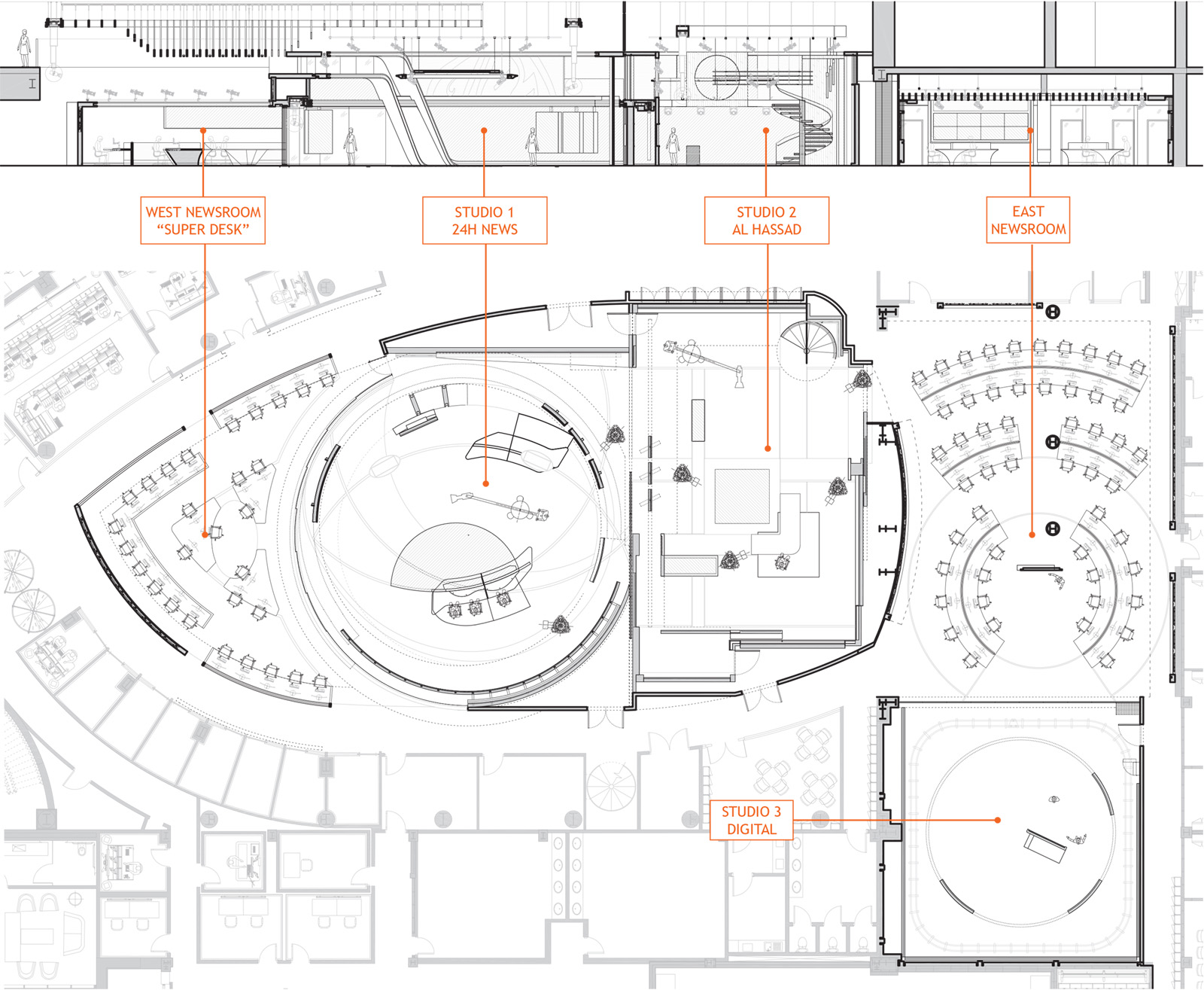
An overview of the three spaces inside Studio 5. Courtesy of Clickspring Design.
“The resulting design is at once a holistic realization of Al Jazeera’s vision, yet also a truly unique series of spaces that can function independently of each other,” said Steven Dvorak, senior vice president of design at Clickspring, while also noting they can be used in concert.
The first newsroom work area forms a dramatic point with a seating capacity of 31. Workstations fan out in a slightly asymmetrical layout that matches the existing walls and wraps seamlessly around a custom built “super desk” in the middle that’s three sided to match the curve of the workstations but also has seats in the middle.
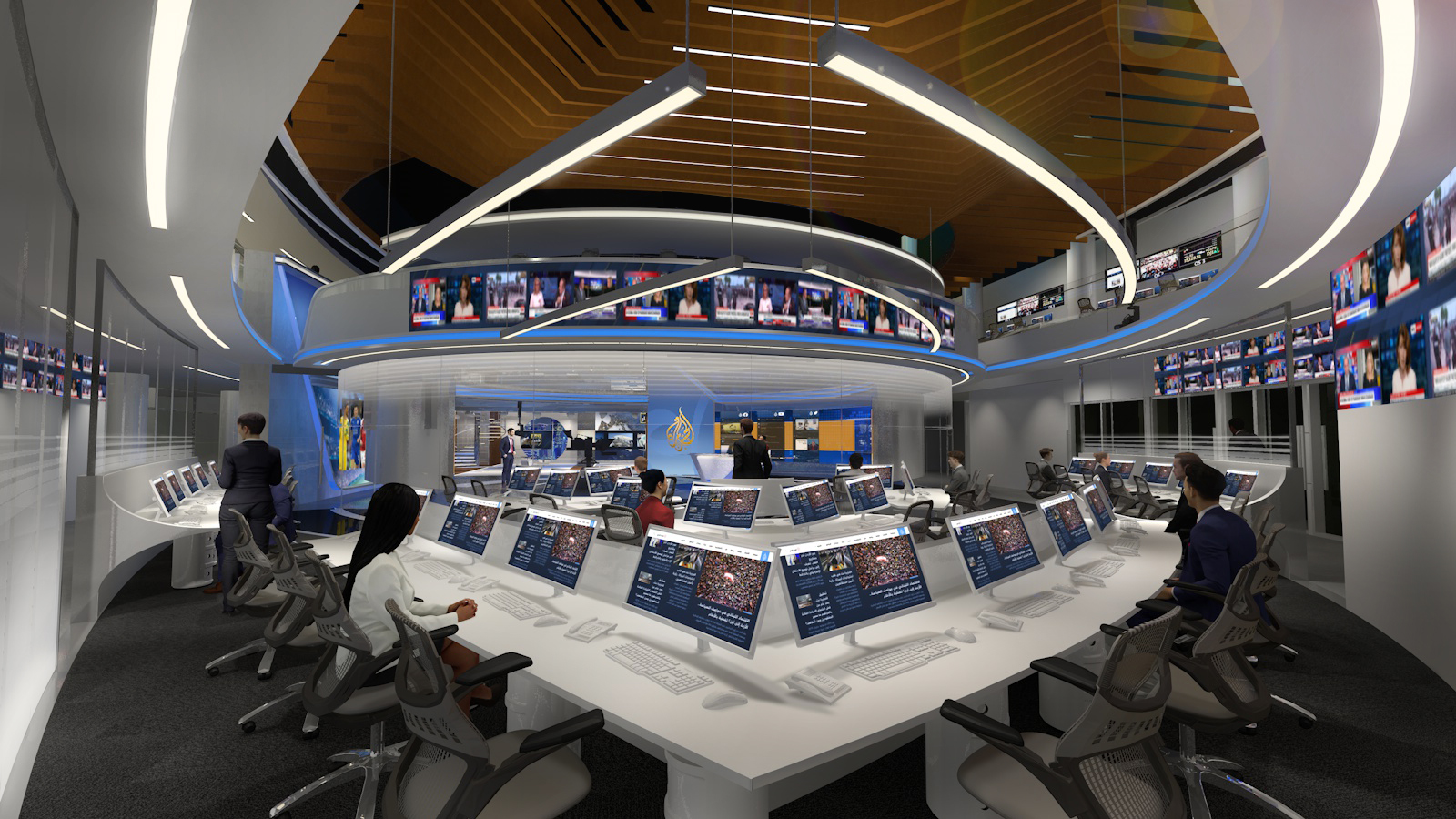
Rendering of the “super desk.” Courtesy of Clickspring Design.
Set 1: The 24-hour news studio
Set 1 sits roughly in the center of Studio 5 and adjacent to the west newsroom. It is home to the network’s 24-hour news programming, and has a circular footprint ringed with a myriad of hard scenic and LED video elements.
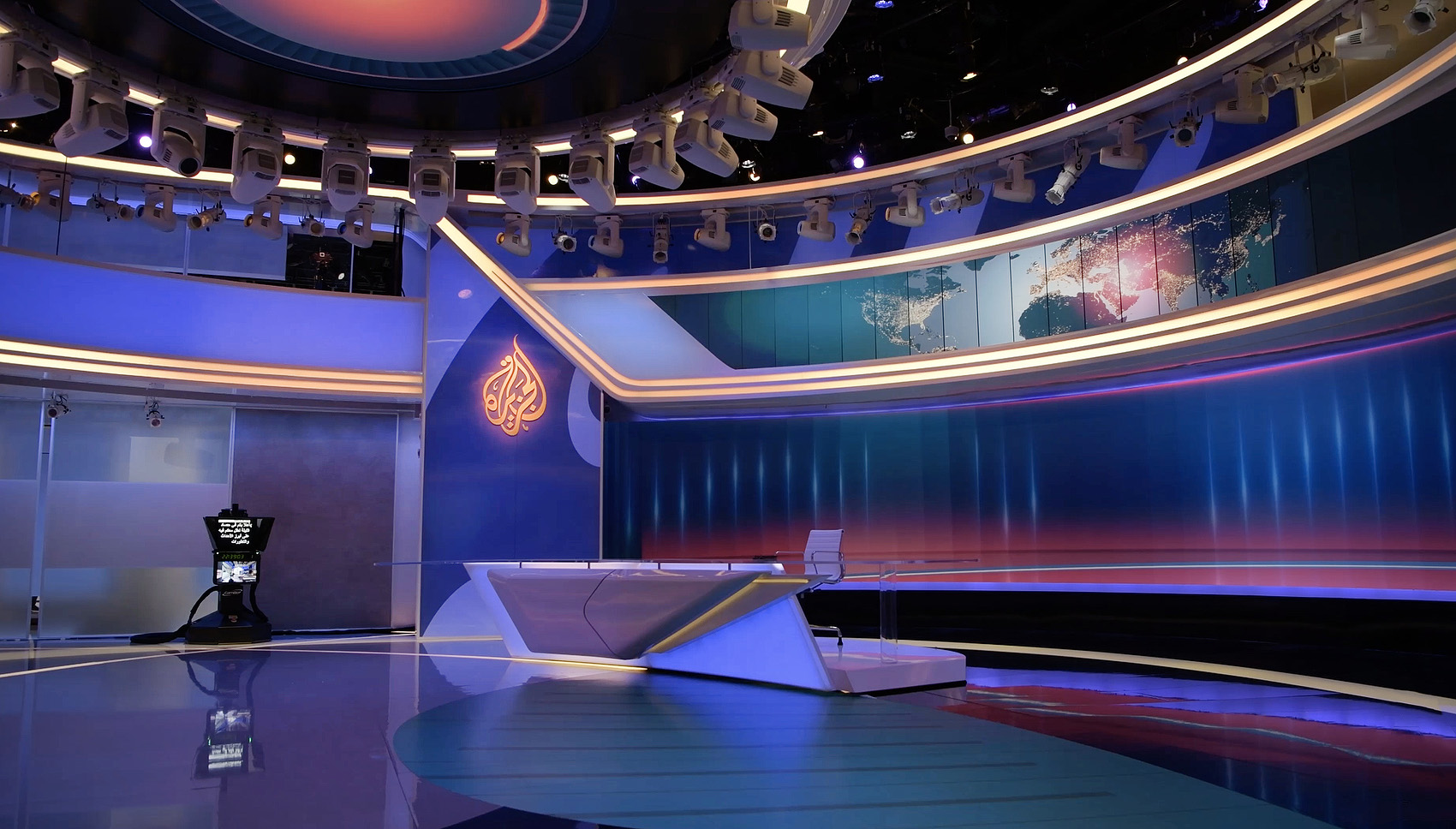
Set 1.
However, instead of just large curved walls of LED, Clickspring worked in numerous ways to tweak scale, orientation, size and even shape beyond what can be created using traditional LED tiles.
“We need to change the atmosphere of the studio during the day,” noted Moawad. “We need to renew the look of each period of coverage during the day. Each corner of the studio has its own function and is dedicated to a certain period of coverage.”
All of the spaces include video panels that not only give the network the now commonplace ability to change backgrounds, but also to use various segments in exciting ways. These include custom manufactured LED displays from AOTO, supplied by fabricator Get Set.
While Set 1 does have two more traditional vista walls, there’s also a tower that, at the top of the double-height space, is intersected by a strong curvilinear structure that snakes up to the ceiling.
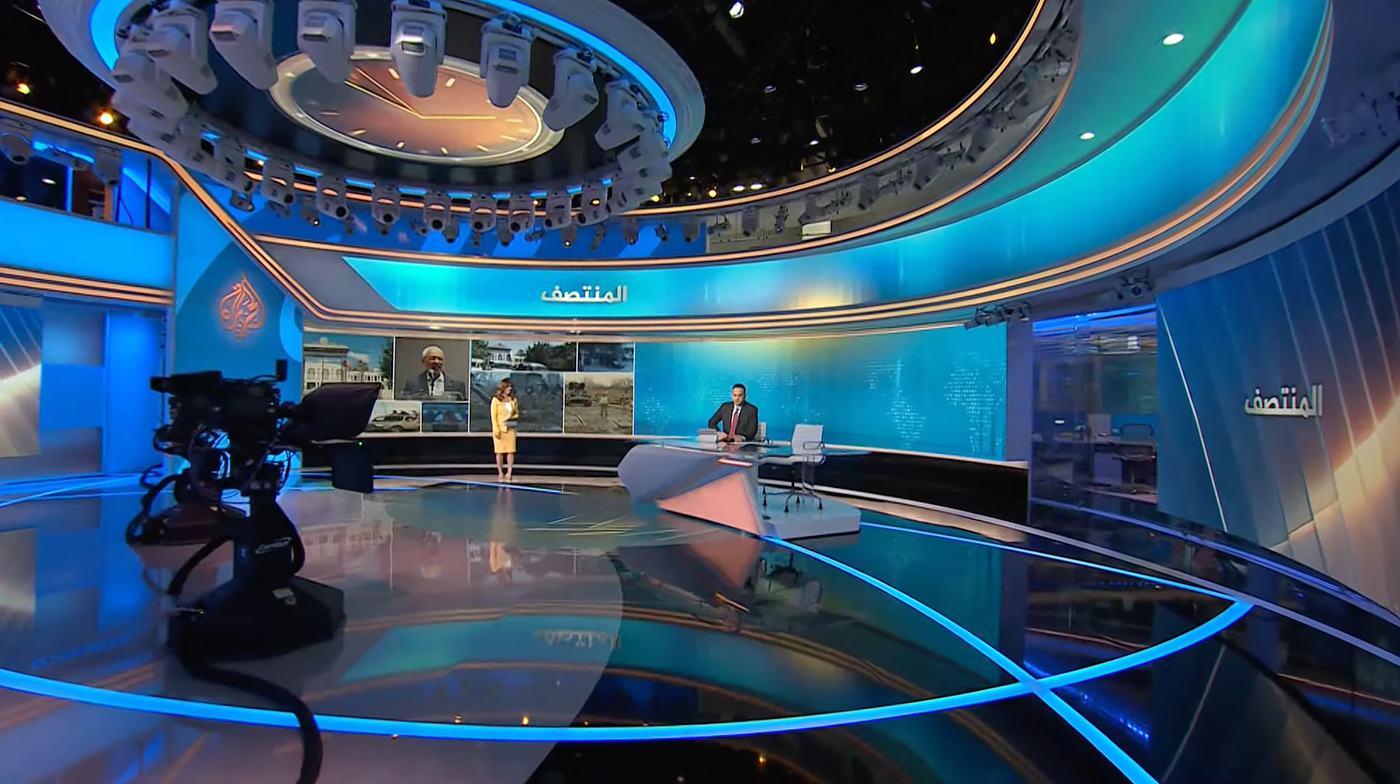
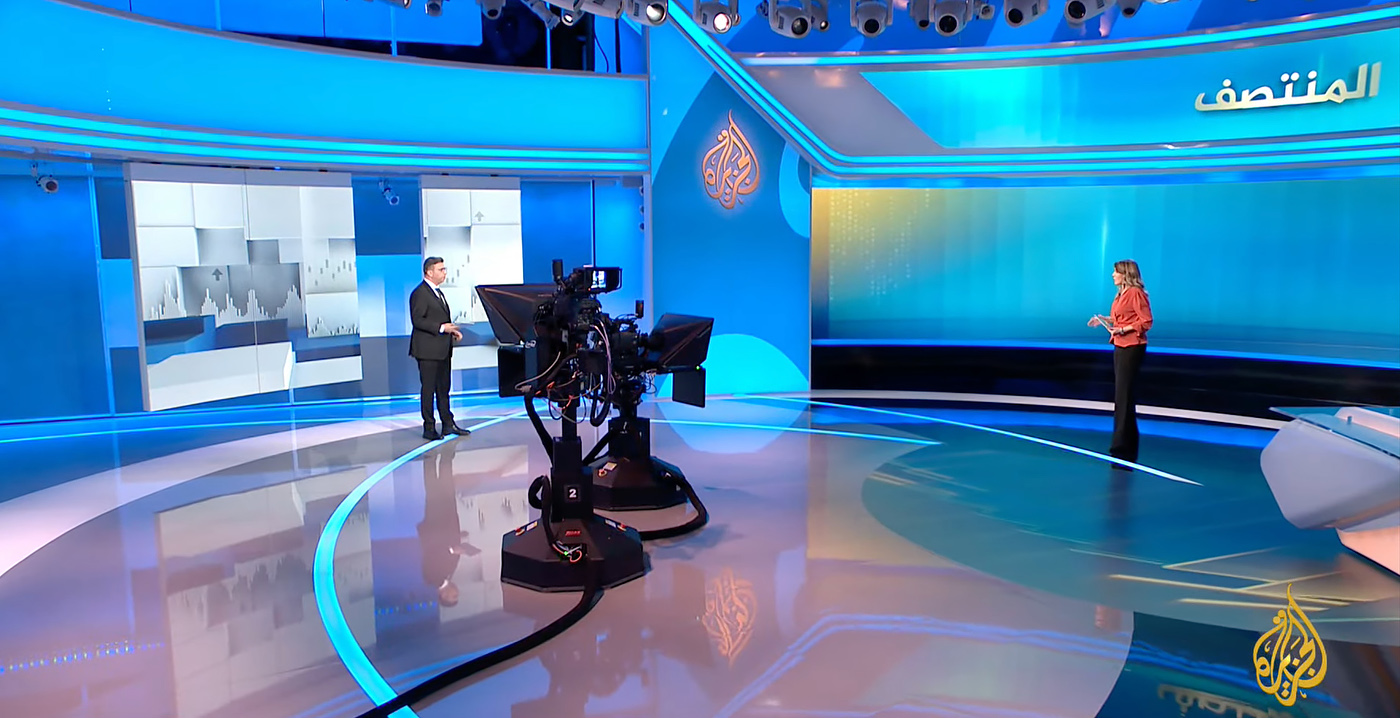
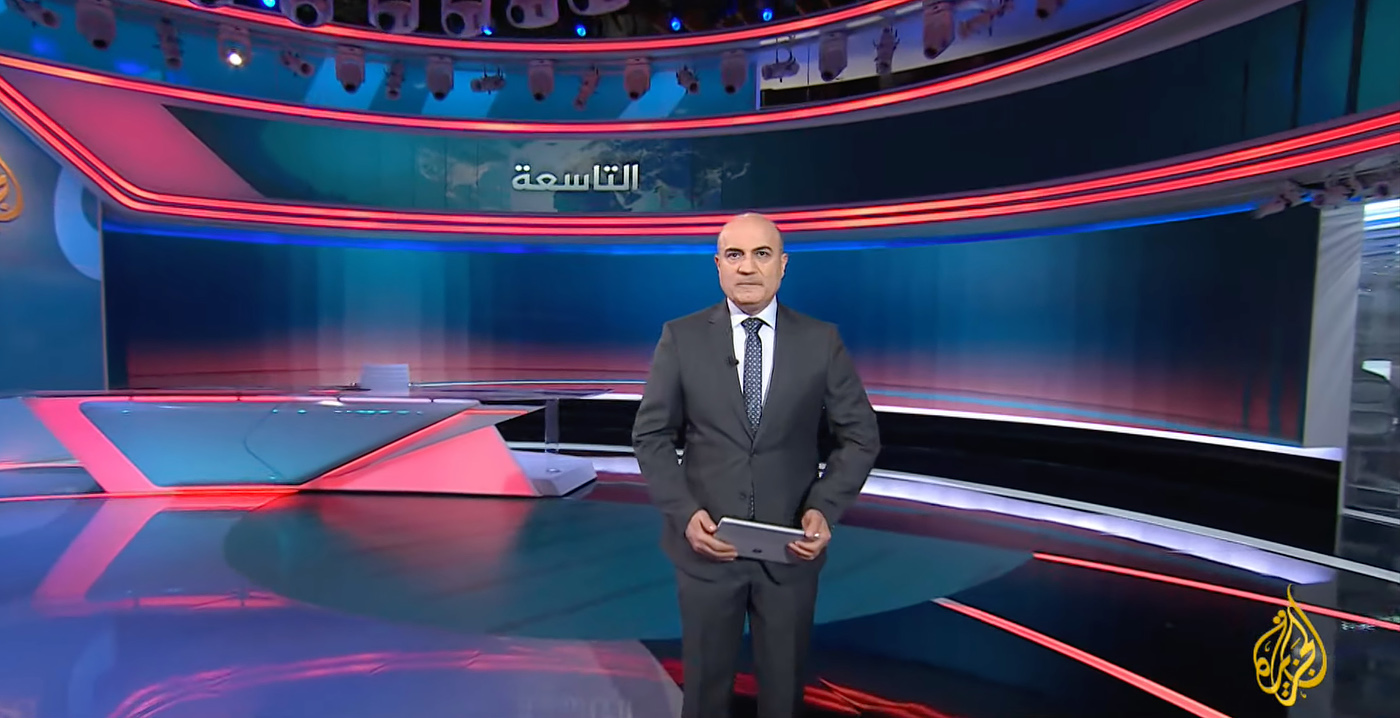
Another area of the studio is dramatically bisected by a larger interpretation of this element, while high above the center is a circular LED chandelier ringed with robotic theatrical lighting.
The floor features a petal-shaped LED video panel and a multisection anchor desk that continues the network’s use of dramatic angles that coordinate with the curvilinear elements but can be broken up and mixed together in a variety of ways.
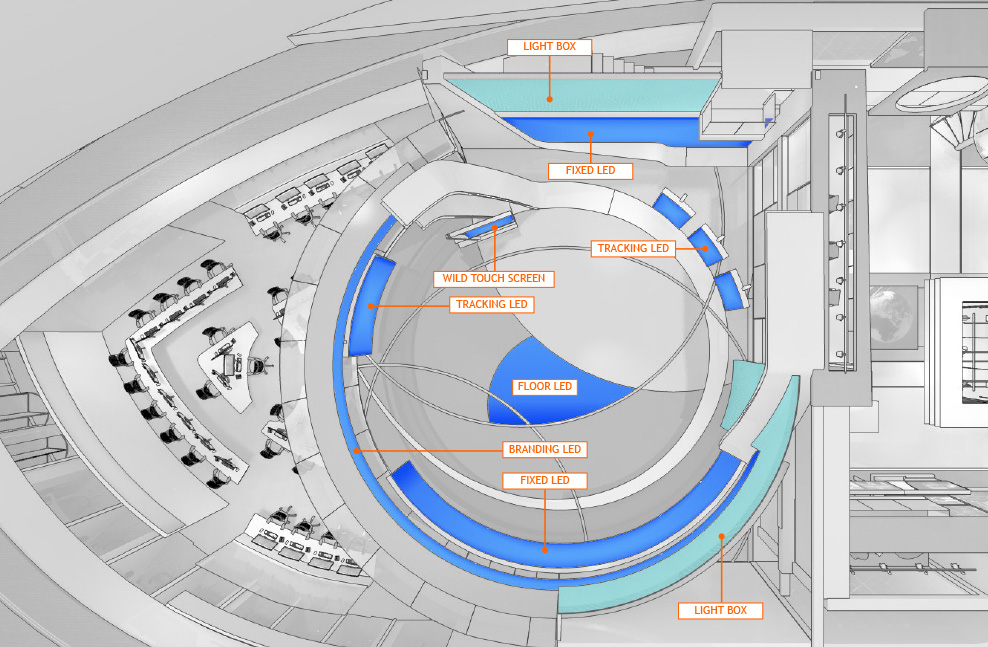
The LED technology in Set 1. Courtesy of Clickspring Design.
For example, there are options for one, two or more anchors or guests behind the desk. Individual segments can also be moved to another location in the space for a small standup pod, making it possible to create a standup area in almost any part of the space.
Multiple segments of seamless curved LED can be moved around an overhead track system, giving the station numerous options for creating venues. This includes a large curved segment that can be placed in front of the newsroom, giving this venue a large digital canvas for storytelling.
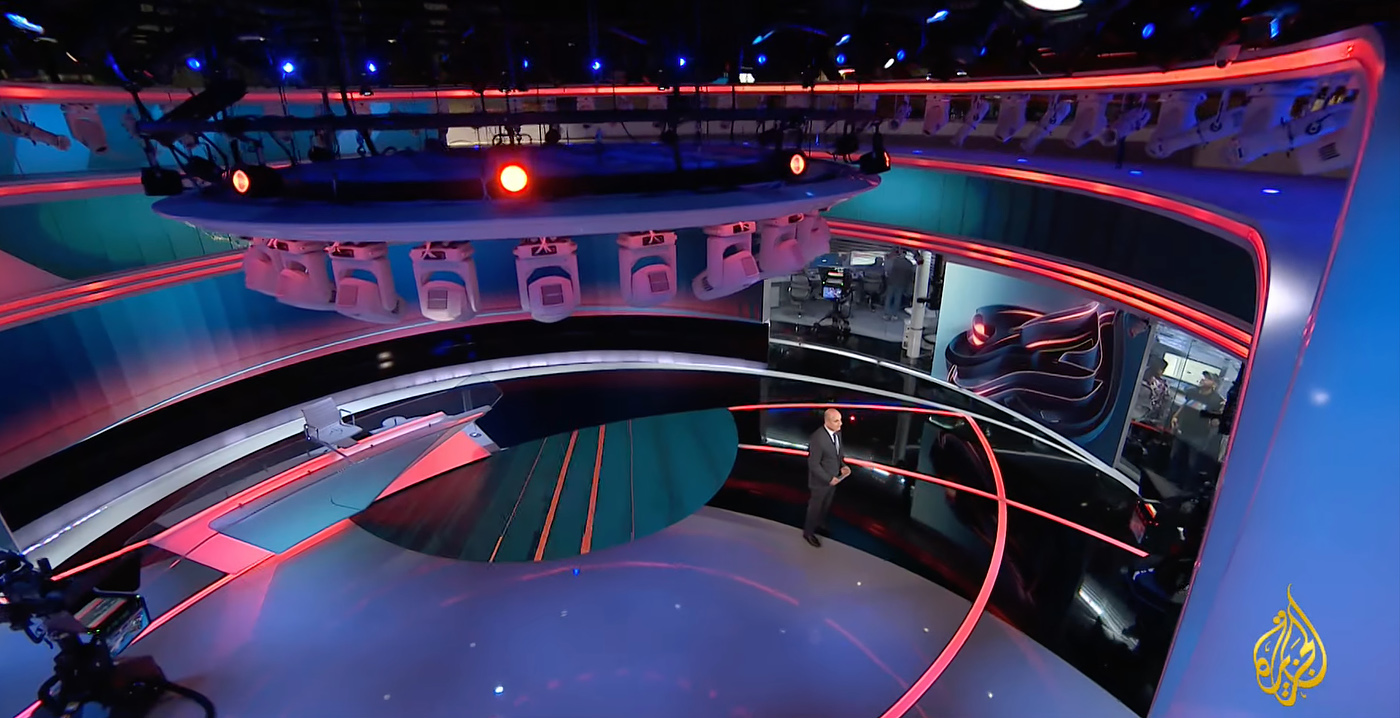
However, it doesn’t stop there. Clickspring’s design called for the various TVs in the newsroom — normally tuned to channels around the world — to be dynamically taken over by the control room via IP technology. These can then be used as additional coordinating background elements when shooting in this area.
Special emphasis was placed on interaction shots between talent and guests as well as technology.
“We brought steady cams into every one of the broadcasts to give them a much more mobile, a much more exciting, a much more ‘walk and wander’ feel to the shooting pattern,” said Eric Siegel, a director who consulted on the project.
“One of the great features of this project is four enormous Ross Video Furio SkyDolly tracks,” said Siegel. “There’s a track that’s around 60 meters and it circumnavigates the entire complex.”
These robotic camera systems allow the network to discreetly capture cross shots from a multitude of vantage points.
“Because we didn’t want to fill the studio up with cameras, we had a large circular track that went all the way around the studio at a height of about eight or nine feet with two cameras hanging down from that.”

Two of the robotic camera tracks also run around the perimeter of most of the newsroom spaces, allowing the network to give viewers a glimpse into the newsgathering process.
The top portions of the new scenery in the Set 1 area, meanwhile, feature additional LED ribbons and frosted panels that reveal the balconies used to access the work areas that ring the upper part of Studio 5.
Set 2: The home of the evening news
On the east side of the circular space is an area that transitions to Set 2, designed for the network’s signature evening newscast, “Al Hassad,” or the “harvest.”
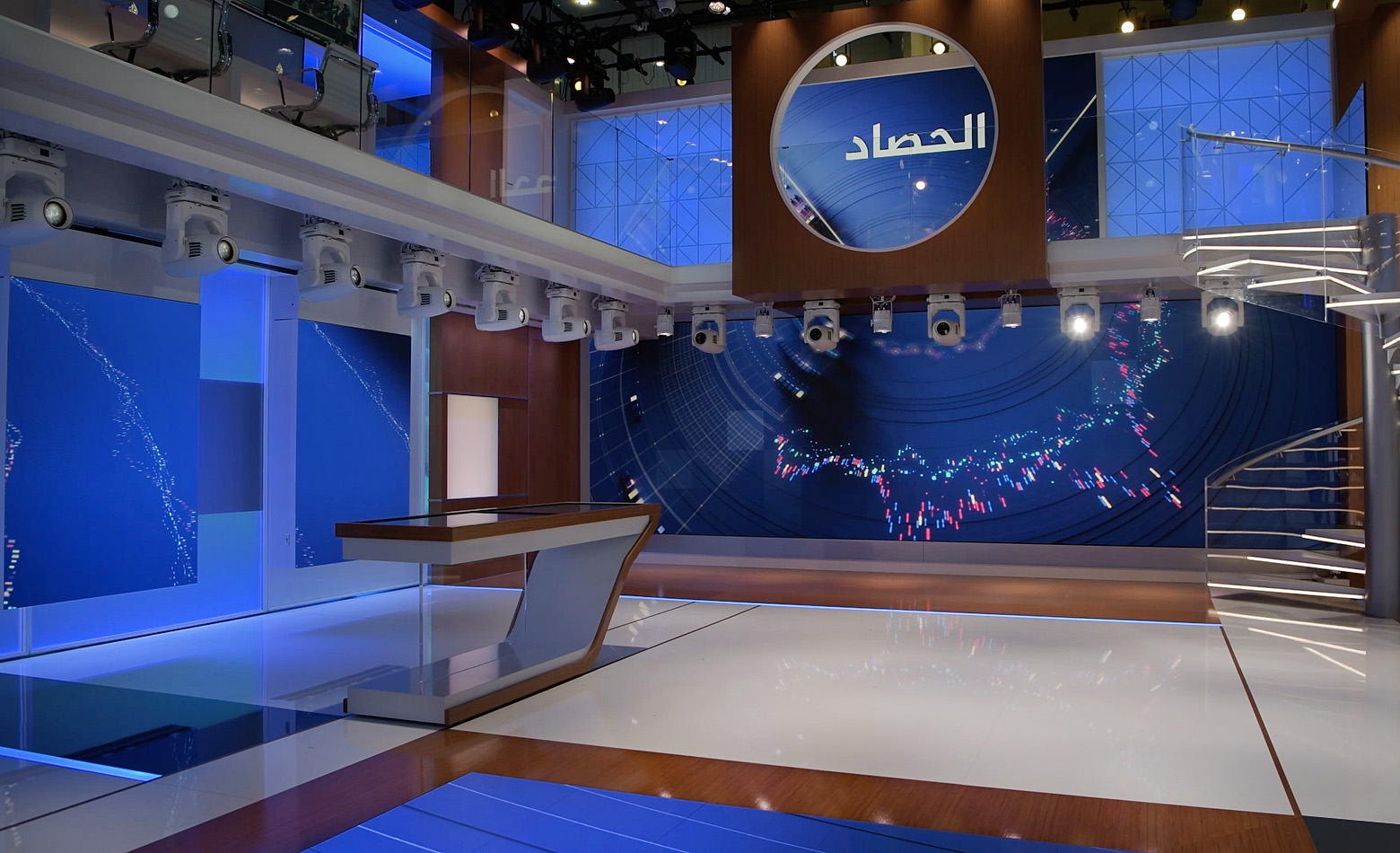
Set 2.
The two studios connect seamlessly through an opening that’s about half the width of both sets. This can be kept entirely open to allow interactions and camera moves between the two spaces during special coverage.
When more division is needed, however, solid sliding scenic walls along with a trio of curved, trackable LED panels can slide over the opening, mostly obscuring the neighboring studio and giving additional LED storytelling surfaces.

Unlike Set 1, Set 2 purposefully moves away from the curvilinear design elements using a footprint of rectangles — with some key circular accents worked in that coordinate with the graphics package.
“This set instead focuses on a more intimate, warm and residential look and feel,” said Dvorak.
The overall vision for Set 2 is based on the presenter recapping the day, noted Moawad. “From the first moment of the opener, the presenter is moving around, engaging with the audience and showing them news from around the world.”
The design keeps the show flowing through unique spaces built around the idea of a clock, which is also included in the design.
The west side of the space, which connects to Set 1, features three pivoting and tracking panels that can be used for everything from remote interviews to social media feeds and story rundowns.
Like the panels next door, they can also be moved completely out of the way into almost any position along the west wall and have been strategically planned to allow the host to sit at the primary anchor desk and face live pictures of up to three remote guests — among other configurations.
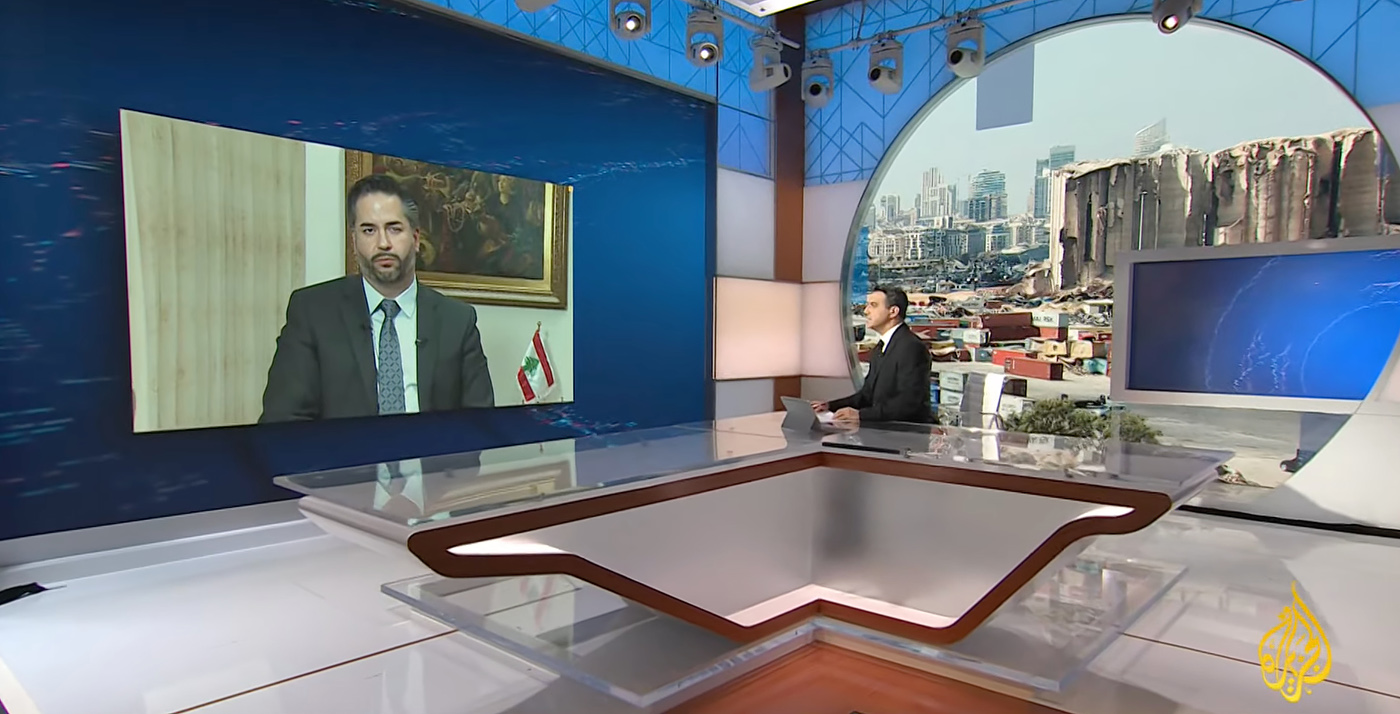
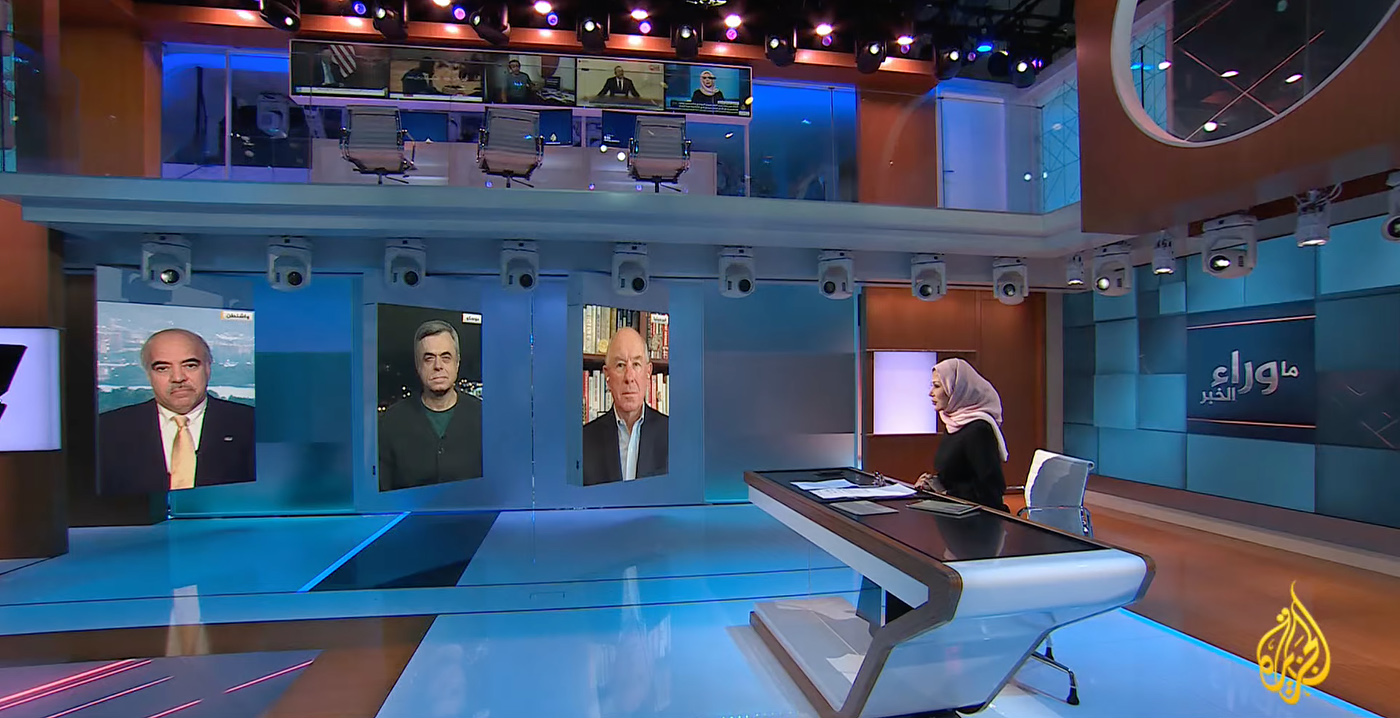
The L-shaped anchor desk allows for a variety of seating positions for anchors and in-studio talent or guest configurations and sits below a four stack of linear baffles and custom lighting.
The west wall of Set 2 features a massive circular LED vista wall that can be used to showcase dramatic graphics and imagery, often tied into the show’s new graphics.
Clickspring also included a position on the right side where a wild touchscreen cart docks almost seamlessly with the hard scenic to add another layer of LED.
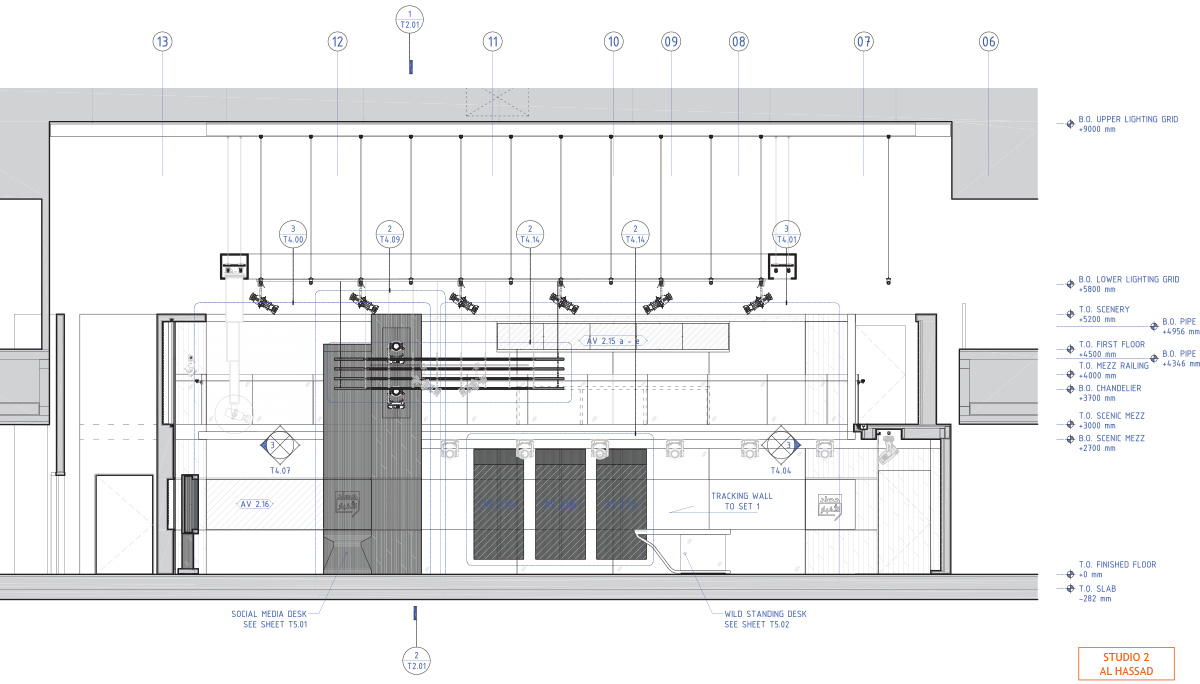
Set 2 drafting elevation. Courtesy of Clickspring Design.
Set 2 features two additional desk areas. The first is a wide cantilevered surface extended from a glossy column with open, curvilinear supports and equipped with touch screens in place of glass or a solid desktop. This allows them to become interactive explainer stations or for data visualization and other storytelling or, when the screens aren’t in use, additional desk-like venues.
Another, freestanding unit with a touchscreen top is also available, along with an additional, smaller area with an integrated rectangular video panel for branding and topical graphics.
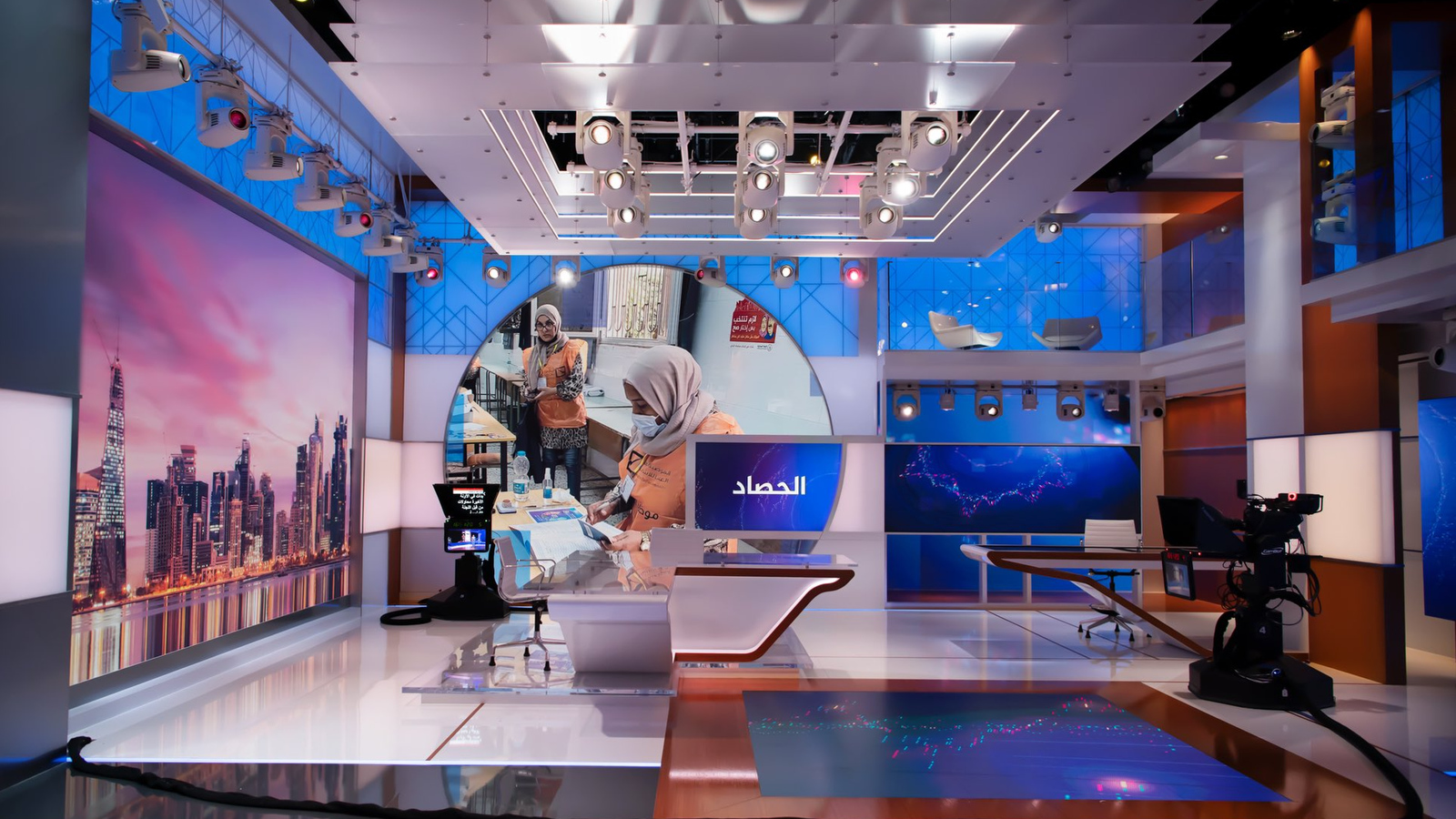
Here again, the space also includes more traditional seamless swaths of vista walls, one on the east side and one along the north, which is situated camera left of a sculptural spiral staircase fashioned of edge lit glass and crowned with a circular opening. This is buttressed by an additional LED panel behind it on the second floor.
The southwest corner, which is topped with an informal seating area on the mezzanine level, includes an additional venue below with an LED ribbon supported by solid structural elements and backed with a faceted LED lit wall.
“I’ve seen studios that look like a space aircraft,” joked Moawad. “The balance was to make sure the screen has a purpose. Everything has a function and is being utilized for the news delivery.”
To the east of Set 2 is the second newsroom, which can be hidden with a large tracking panel system. This newsroom is smaller and rather narrow, but curved desks and lighting elements on the ceiling give it a less constricting feel.
A standup location that’s placed quite literally in the middle of the newsgathering teams along with a custom wild monitor cart can be used for brief updates or reports.
The newsroom is also fully wired — from broadcast service panels to theatrical lighting and controllable monitor walls — to be used on a more expansive basis if needed, essentially becoming a fourth set.
Set 3: Designed for digital production
South of the newsroom and separated by large sleek glass panels that can open is Set 3, which is dedicated to digital productions and short form programming.
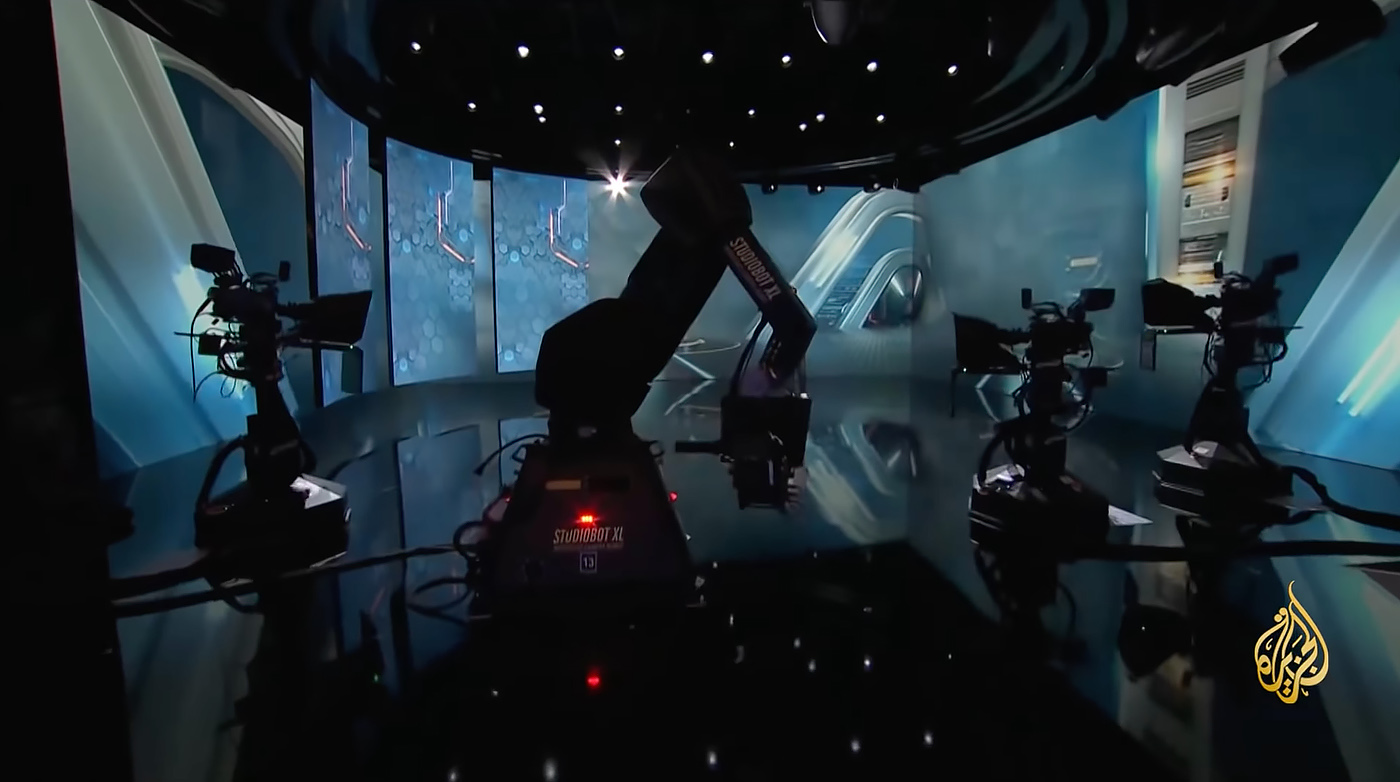
This area has the feel of a black box space except that it’s clad in nearly floor-to-ceiling LED panels on three sides. An overhead circular tracking system holds three vertical video towers that can be arranged in a variety of positions and combinations — and obviously fed a wide variety of graphics.
A wild monitor cart can also be used here as well and, like the others, the space is shootable from any angle, meaning the newsroom can also be used as a background.
Set 3 also includes a Mark Roberts Motion Control StudioBot robotic jib with a teleprompter to take full advantage of the impressive height of the space.
“There is a unique flow between the sets and newsrooms. Tracking walls divide all the spaces yet can be opened to create one ‘super studio’ that can be dynamically captured with tracking and steady cameras, producing a truly cinematic experience,” said Kendra James, senior design director at Clickspring Design.
Indeed, it’s easy to envision how handheld cameras moving nimbly around the space could be used to cover major news events, moving the viewer physically from one part of the complex to another, with each venue serving a distinct purpose and giving talent tools to enhance the stories they tell.
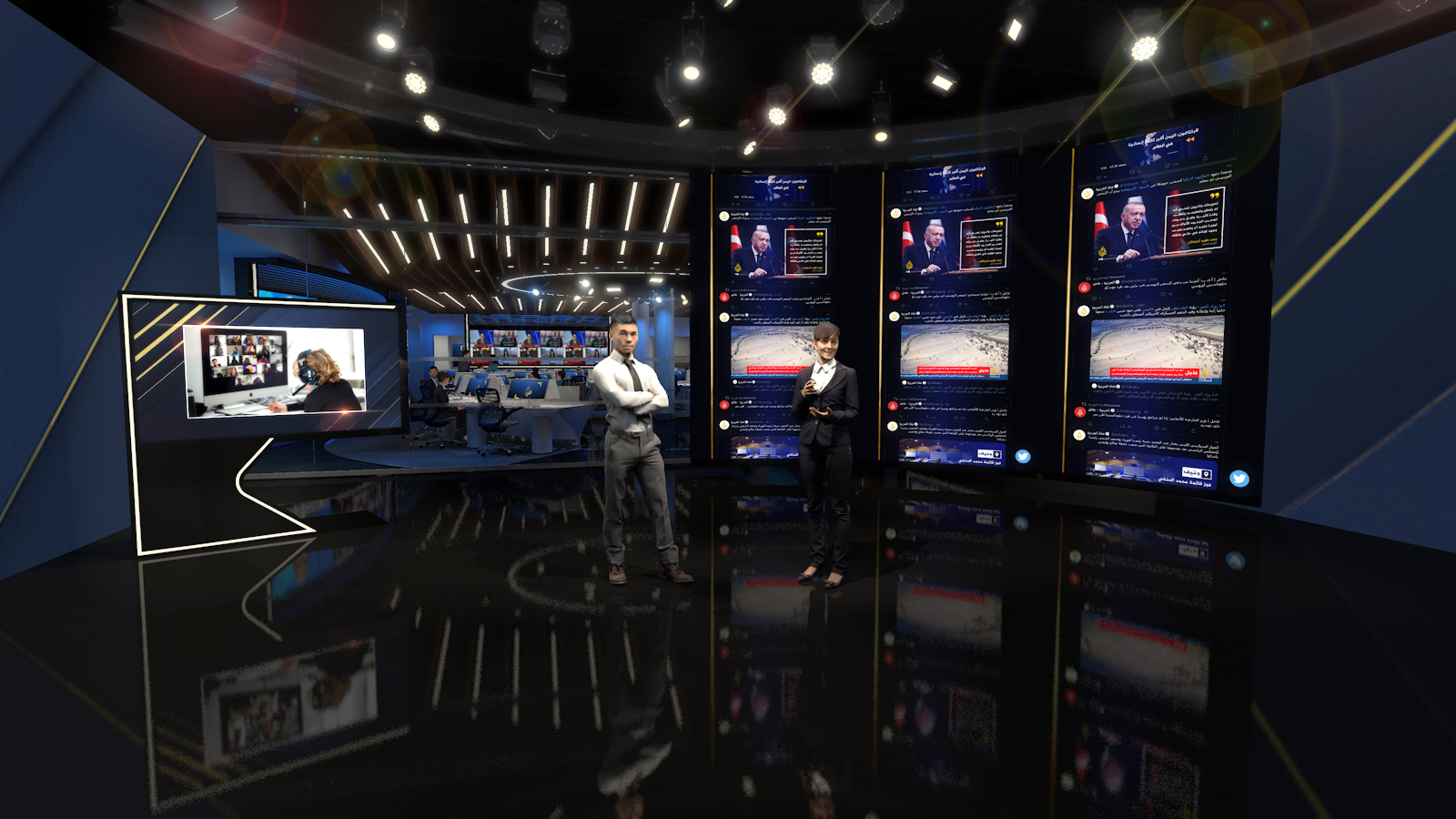
Rendering of Set 3. Courtesy of Clickspring Design.
When creating the new look for Studio 5, Clickspring strategically sourced LED from AOTO. Much of the perimeter LED has 1.2 pixel pitch while tracking elements are 0.9.
This allows the Ross Video robotic cameras to be positioned extremely close to the video walls and cuts down on concerns about moiré effects and pixels becoming visible to viewers — instead delivering reliable, crystal clear backgrounds.
All three set feature extension video wall graphics and branding from Astucemedia, who worked with the network on its new on-air design package.
Lighting the new sets
The lighting design in the new Studio 5 is another feat in and of itself. Over 1,200 lighting fixtures were brought in and carefully positioned by the Eastern Lighting Design team.
“We realized pretty quickly that we needed to try to utilize intelligent lighting fixtures in order to reduce the overall fixture count and have one light be able to have multiple purposes,” explained Eastern Lighting Designs’ principal and president, Matt Gordon.
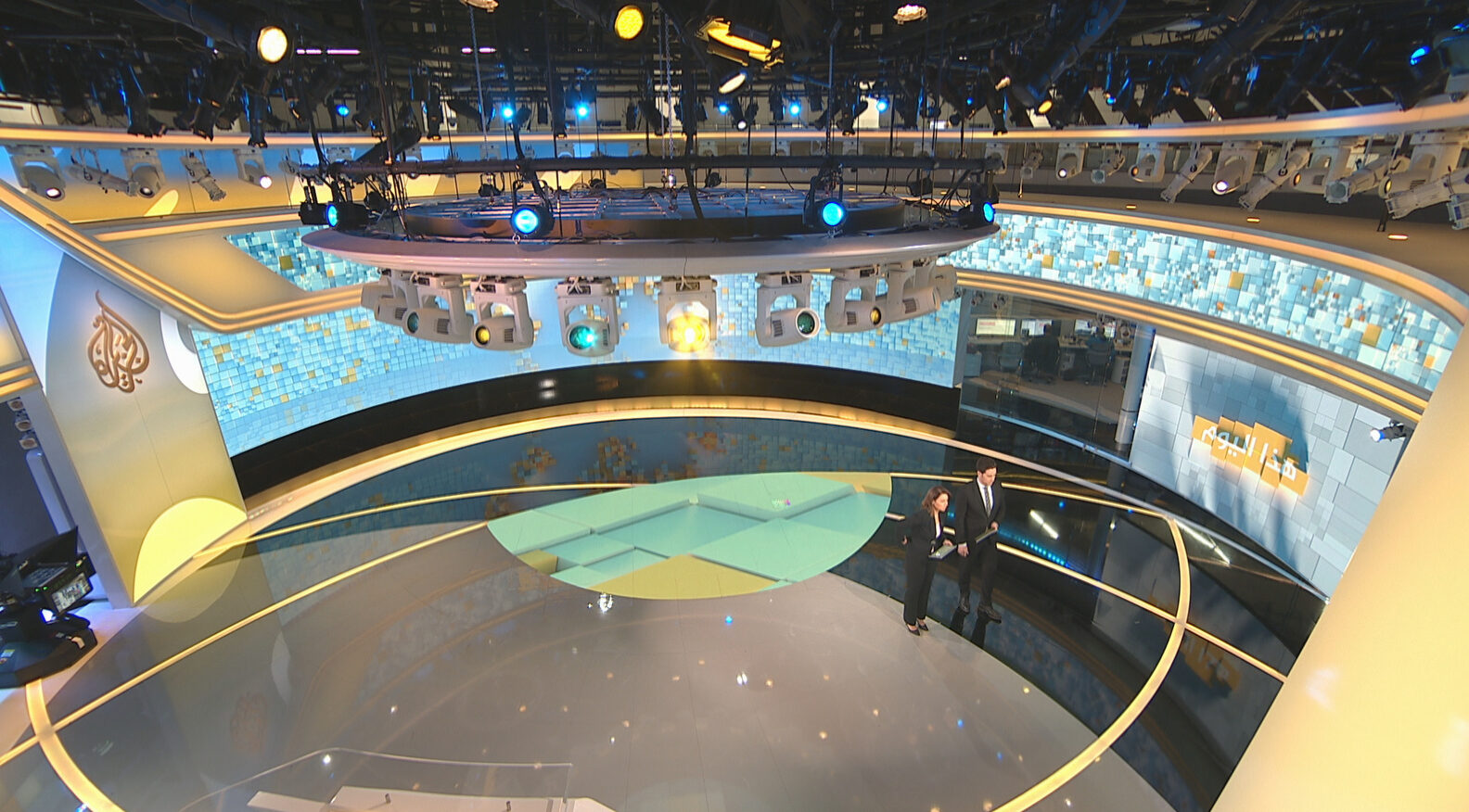
These robotically controlled lights are also capable of a wide variety of synchronized effects in addition to simply hitting specific cues to illuminate talent and the set, giving the network an extraordinary amount of flexibility for creating unique looks for different dayparts and programming — including ones that haven’t even been developed yet.
Clickspring worked closely with Al Jazeera’s graphics team to ensure that video panels could serve a purpose as anchor backdrops, explainer graphics, social media feeds or even in the background of augmented reality segments. There may even be additional options.
“The most unique aspect of the Al Jazeera Studio 5 project is that, from its outset, the project was approached as a creative response to a larger editorial vision — allowing aesthetic solutions to be guided by that vision,” said Dvorak.
The ultimate result was a broadcast environment that took both form and function into consideration and incorporated top-of-the-line technology in a carefully planned way to enhance newscasts — not just to sit in the background.
Designers and producers have a wide variety of both digital and real-life opportunities to bolster the channel’s in studio conversations, on camera explainers and in studio storytelling.
This included careful consideration — not just installing as many video walls as possible (though there’s no shortage of them) but also thinking about how the people and hard scenic elements would interact in concert with them.
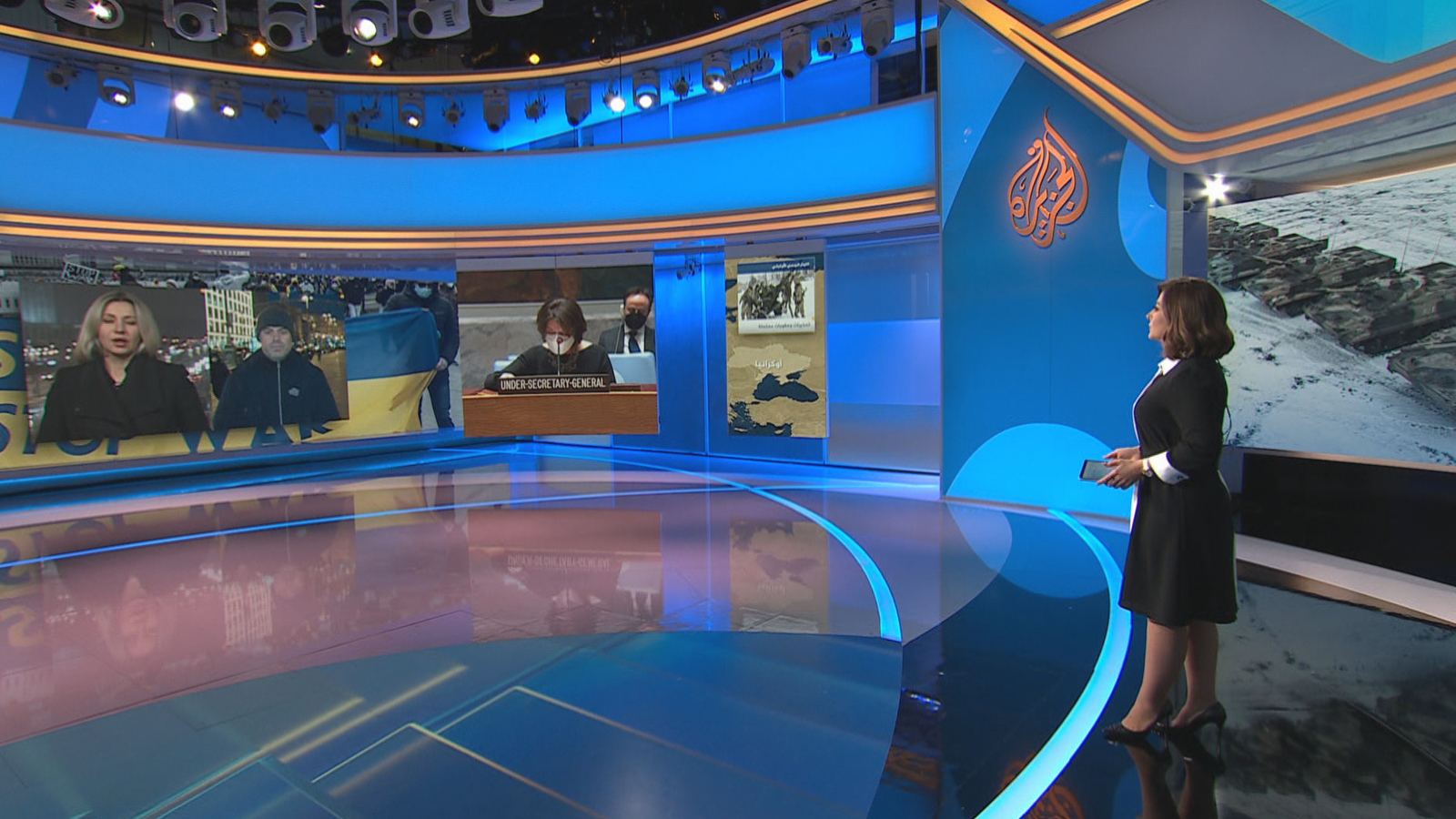
There are wide video walls for standard topical backgrounds, timelines or other similar segments. Tall LED towers and tracking panels are ideal for graphics or video feeds that work better in portrait orientation.
Circular and movable video panels — some of which are touch enabled — provide even more opportunities for covering the news in a more complete and comprehensive way. Meanwhile, bold scenic elements complement the LED, prevent the look from becoming overly digital and still let talent stand out.
Use of the upper space of Studio 5 thanks to LED headers, structural elements and balconies not only provides additional venues, but can play a key role in enveloping the set in with a cohesive look that feels polished and professional.
“With this facility, Al Jazeera has not only invested in its own future; they have also directly shaped the future of broadcast media globally,” stated Christopher Ferguson, director of business development and account manager at Clickspring.
“A change means something that the audience is talking about,” said Moawad. “People noticed and that’s very important.”
Since the relaunch, Moawad also notes an increase in viewership for the two main evening news programs.
“We have noticed a change in the viewership, they are starting to connect to the show and building a habit,” said Moawad. “We are seeing a new pattern where people are turning on to see a specific show, not just for breaking news.”
Explore more of our in-depth look at the relaunch of Al Jazeera including the new motion design, directing style and theme music.
Project Credits
Designer: Clickspring Design
Lighting Designer: Eastern Lighting Design
Set Fabricator: Get Set
On-Air Graphics: Astuce Media
Sonic Design: Stephen Arnold Music
Lighting Systems Integrator: LSI Projects
AV Systems Integrator: Danmon Group Systems
Broadcast Cameras: Ross Video
LED Video Walls: AOTO
Theatrical Luminaires: Ayrton, ETC, ChromaQ, Rosco, Martin, Enttec
Lighting Control System: Luminex
Civil / HVAC Systems Contractor: ADMS
Civil Contractor: ENCO
Power Contractor: CCTC
Subscribe to NCS for the latest news, project case studies and product announcements in broadcast technology, creative design and engineering delivered to your inbox.






